Scandals of Classic Hollywood: Rock Hudson, Hollywood’s Most Eligible Bachelor
by Anne Helen Petersen
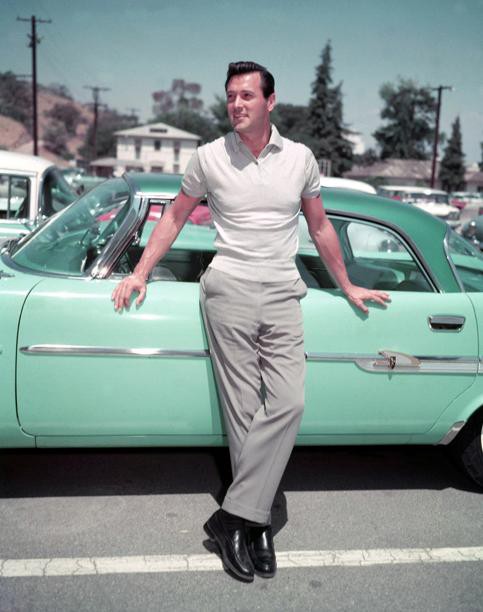
Imagine a man built like a tank: 6′ 5″ frame, barrel chest, square jaw. This man speaks with a low voice, sports a full set of hair, and tantalizes his female fans with his persistent bachelorhood.
But this man is also skilled dancer, a masterful flirt, and the consummate gentleman. He plays sensitive characters who aren’t cry-babies but who feel so many emotions, and his outfits are always coordinated, whether they’re three-piece suits or a flannel work shirts and jeans.
This man was the perfect projection of what women of the 1950s and ’60s thought they wanted when they fell asleep at night. And that projection — named “Rock Hudson” by a crafty agent — was a complete fabrication.
Hudson was not only the most famous closeted star of classic Hollywood, but he was also one of AIDS’ most famous victims, dying of the disease when it (and homosexuality in general) were still very much taboo. But what made the revelation so scandalous? Sure, he had a fake name, but most stars did. He was in fake relationships intended to bolster public interest in his films and shut down gossip about his actual personal life, but that was true of all Hollywood stars in the classic era, male and female.
The problem, then, was that when Rock Hudson admitted that he had AIDS in 1984, he made it unequivocally clear that his entire image was a lie. And that those who’d believed it — fallen for it, worshipped it, used it as a model against which all male prospects would be judged — had been duped.
It wasn’t just that Hudson played “straight” roles onscreen. He (and the gossip machines) had presented the “real” Hudson, the non-acting Hudson, as a paragon of masculine heterosexuality. And it was that deception — more than the fact that Hudson liked to have sex with men — that fueled the scandal. If Rock Hudson could be gay, then who else? What other star images were predicated on falsehoods? Was all of Hollywood a lie? Did it matter?
But let’s go back. Since no respectable mother would ever name her son “Rock” (today we just name our children after Twilight characters), there’s obviously a creation story.
A boy, then named Roy, had a predictable, un-starry Illinois childhood. He sang in the glee club (duh), but had no remarkable talent. He served as an auto mechanic in the Navy during World War II, and afterward moved to Hollywood.
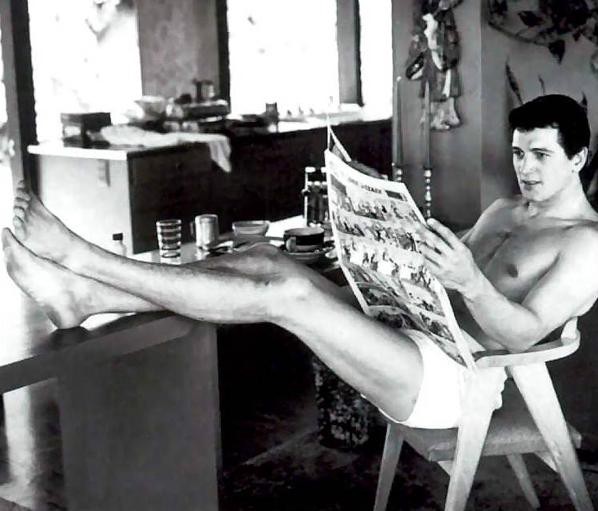
At this point, Hudson looked very much as he would for the rest of his life, which is to say he looked like a Ken doll with a dye job. The same classic good looks, the same soft, inviting smile. But dude could not act FOR SHIT.
Nevertheless, Roy caught the eye of Henry Willson, who quickly renamed him “Rock Hudson.” Willson managed to finagle him a bit part in the war drama Fighter Squadron, but Hudson famously took 38 takes in order to properly deliver a single line. So Henry Willson went to work turning Rock from a dolt into a star.
Now, Willson was gay and well-known as such, making his name as a talent scout by cruising gay clubs and picking up the most handsome, square-jawed, Captain America-type specimens for uses both personal and professional. After World War II, Willson started his own talent agency, specializing in producing the type of male star that post-war audiences seemed to hunger for. Instead of the Continental men-about-town, these men were strapping, virile, and Midwestern-wholesome. In other words, servicemen. Or at least the stereotypical image of a serviceman, all milk-fed and ready to go do Man-Things.
Willson would take these Captain Americas, usually have sex with them, strip them of their names, and rebuild them from the ground up. He gave them preposterous yet catchy stage names that somehow combined the very normal with the very unique. There’s Rock Hudson, of course, but there’s also Troy Donaghue, Tab Hunter, Rory Calhoun, Guy Madison, Clint Walker, Clint Richie, Chad Everett, Guy Williams, Grant Williams, Van Williams, Cal Bolder, Rad Fulton, Rand Saxon, Race Gentry, Chance Gentry, Chance Nesbitt, and, best star name of all time, DACK RAMBO.
Obviously, repetition was not a problem. When a new “star creation” didn’t take, Willson simple gave the name to his next endeavor. He’d bestow the star with “masculine” hobbies — woodworking, horseback riding, football — and rewrite their personal narratives to best appeal to what audiences seemed to crave.
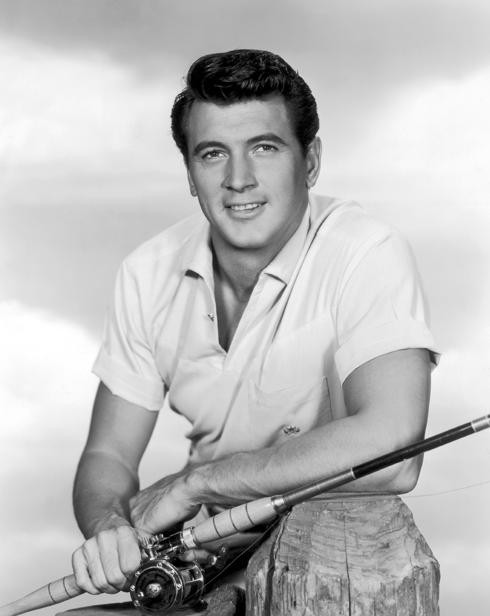
Real men like fishing rods.
Since the majority (but not all) of Willson’s clients were gay, he also put them in training to “rewrite” any stereotypically effeminate gestures. Limp wrists were slapped; swaying hips were straightened. They learned how to light a cigarette “like a man,” with a swift single motion. In other words, they went to Straight Guy School, and, with the help of the fan magazines, audiences ate them up. Very few became huge stars the way that, say, Clark Gable was — their images were too hollow to sustain the weight of actual superstardom — but for all of their derivativeness, they filled the B-list and made girls swoon, the same way that so many male stars on ABC Family and Disney have that vaguely-Bieberish-yet-ambiguously-ethnic look.
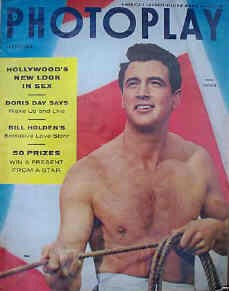
But Hudson was the most famous product of the Henry Willson school of starmaking, and Willson eventually landed him a contract with Universal, which put him in a string of stinkers but worked to capitalize on his hunky image. Even with supporting roles in bad movies, the fan magazines still had him advising female readers on the best way to win a man’s heart.
But in 1954 Hudson landed a role in Magnificent Obsession, a four-hanky melodrama starring Jane Wyman, first wife of Ronald Reagan. (Did you forget that Ronald Reagan was a big film star in the ’40s and ‘5s0? And that then he became our president? AND THAT THAT IS RIDICULOUS?)
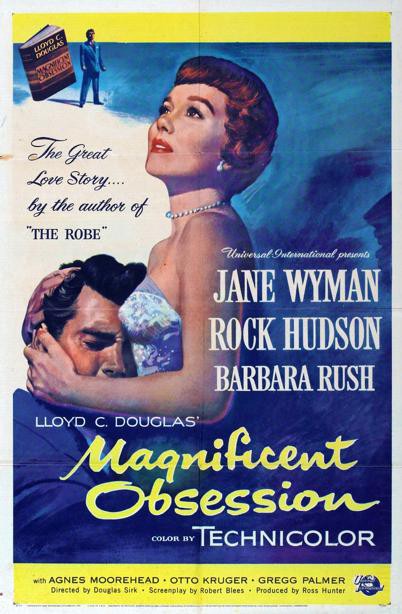
Obsession was directed by Douglas Sirk, the man responsible for the most melodramatic and color-saturated films of our time. Not melodramatic like Armageddon or Pearl Harbor, which belong to a whole subset of action melodrama, but melodramatic like Dear Channing Tatum or Ryan Gosling’s Notebook or A Walk to Mandy Moore Dying Young and Cancerous, which might produce a tear or two on the page but turn into full-fledged emotion-fests on the screen.
Sirk’s films — over-the-top in the best of ways — were considered the Nicholas Sparks adaptations of their time, and were where (mostly middle-aged) women would go to spend what were derogatorily described as “wet, wasted afternoons.” (That sounds like my entire experience of my master’s degree in Oregon, but bygones.) And, as has always been in the case in melodrama, the emotion that couldn’t fit into the performers’ bodies or dialogue overflowed into the mise-en-scene, the costumes, and the score, creating gorgeous filmic tapestries. I mean JUST. LOOK.
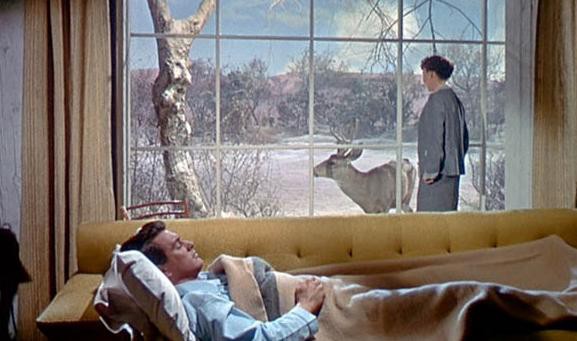
Sirk films are effusive and emotional, they’re bite-your-tongue/roll-on-the-floor absurd, but they’re also maybe the most moving thing you’ve ever seen? Melodrama is complicated like that.
In the years since, his movies have been recognized as masterpieces of the form, offering subtle critiques of American understandings of race, sexuality, domesticity, etc., but that doesn’t mean that they’re not still ridiculous. And Magnificent Obsession, man oh man, it vies for most ridiculous.
So, get ready:
1) Rock Hudson is a party boy. He gets drunk while out motor-boating, bad things happen, and, abbreviated version, a doctor that everyone loves dies.
2) Hudson is sent to the hospital where the doctor works; everyone hates him. He runs away, big sad face, but passes out in front of the car owned by the doctor’s widow (Jane Wyman).
3) Insert long section of Hudson getting released, trying to be a drunk playboy again, failing, and deciding he might be a good person. But then he does something (no telling) that leads to Wyman stepping in front of a car and….wait for it….she goes blind.
4) But then! Rock Hudson decides to reform! And become a medical student! And befriend Jane Wyman, never letting on that he was the one who led to her husband’s death!
5) They fall in love, even though Blind Jane can’t see Hunky Rock. But then! Hudson has Wyman go to Europe for a secret blindness cure. But no one can give it to her, she’s super sad, and Hudson arrives to hold her in his big man arms. And, between tears, drops the bombshell of his true identity, followed by WILL YOU MARRY ME, YOU BEAUTIFUL BLIND WOMAN.
6) Wyman is obviously all about this, but of course it can’t come true at this point in the story, so she decides she’d be too much of a burden and flees into the deep dark night.
7) Years pass. Hudson becomes a badass brain surgeon.
8) But wait, someone brings word that Wyman is on her death bed! To which Hudson rushes! OH GOD SHE’S DYING OF BRAIN PROBLEMS! Who could perform the last-minute surgery? WHO? GODDAMMIT WHO COULD DO IT?
9) Maybe Rock Hudson could do it?
10) ROCK HUDSON DOES IT.
11) Will Jane Wyman survive? Maybe? Yes? OH SHIT LOOK AT THAT, BRAIN SURGERY CURES BLINDNESS! Newly sighted Wyman takes one look at Surgeon Rock, finds him perfect, The End, wipe the massive stream of tears from your face and make yourself look presentable for the walk back to the car.
There’s a reason I just used 339 words of your reading allotment for the day to tell you the plot of that movie, and that reason is that it — and the understanding of Rock Hudson as a manly man full of man emotions — was absolutely crucial to Hudson’s image.
This image was further ratified by two Sirk films in quick succession: All That Heaven Allows (1955), again with Jane Wyman, this time wearing lots of flannel and doing a lot of gardening, and Written on the Wind (1956), featuring Unsolved Mysteries host Robert Stack, Lauren Bacall, and the the best fully-clothed-frenzied-bed-girating you’ll ever see.
But as Hudson became more visible, so did his lack of a wife. Life declared him “Hollywood’s Most Eligible Bachelor,” but explained that “fans are urging 29-year-old Rock Hudson to get married — or explain why not.” (Exchange “fans” for “everyone I went to high school with” and you have my life.)
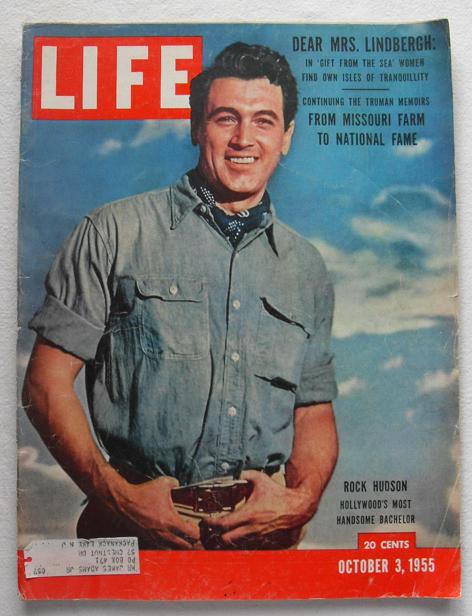
But the real pressure came from a scandal sheet named Confidential, which collected the dirt on dozens of Hollywood stars and their dirty deeds, past and present. Headed by Robert Harrison, Confidential had an army of informants, a garish color scheme, punning purple prose, and promised to “tell the facts and name the names.”
Harrison got his secrets by paying off Hollywood’s lower classes (bell boys, waitresses, and those who slept with the stars behind closed doors), and rumor had it that one of Hudson’s dalliances had taken photos of him in a compromising (read: GAY) position, and Confidential was willing to buy those pictures for $10,000.
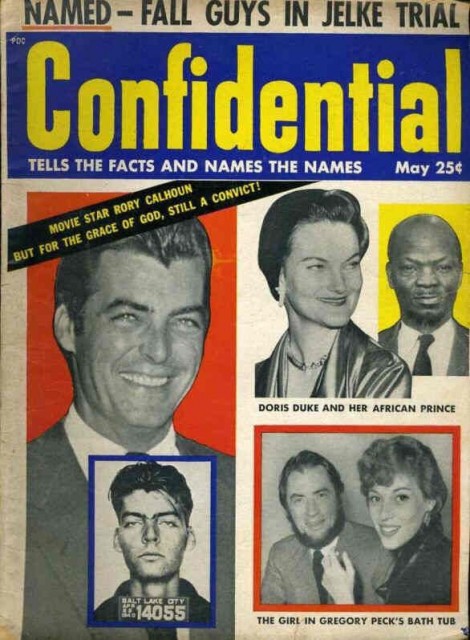
Willson was terrified. Confidential was just a scandal rag, but its readership had reached nearly 4.5 million over the course of a year, and innuendo concerning Hudson’s sexuality could mean the end of the star’s fledging career. Willson thus took immediate action, forging a devil’s pact with Harrison. If Confidential didn’t print what it knew about Hudson, Willson would hand over dirt on two other prominent stars from his man-stable.
The first scandal was somewhat innocuous. Rory Calhoun had been (huge gasp) a juvenile delinquent, but had found Jesus and was now a good guy. Big whoop, as I would’ve said circa 1991, and actually possibly good for his career.
The second, however, was a bit more incendiary. Willson provided Confidential with the details of Tab Hunter’s arrest for “disorderly conduct” with a host of other disorderly (read: GAY GAY GAY) males.
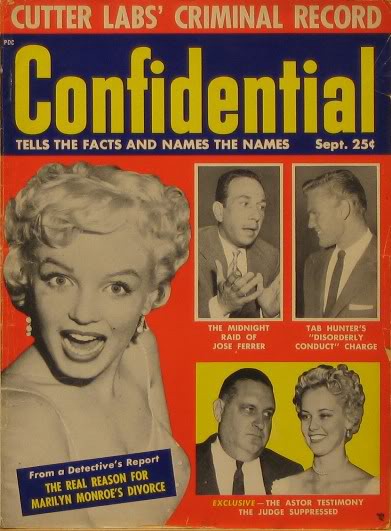
The article, titled “The Truth About Tab Hunter’s Pajama Party,” made it clear that Hunter was hanging out, barely clothed, with “limp-wristed lads” and enjoyed “queer romps.” (The piece was Willson’s jab at Hunter, who had ditched Willson for a new agent just months before.)
Willson next laid the groundwork to shut down any persistent rumors about Hudson’s sexuality, arranging for a marriage between the star and Hudson’s secretary, Phyllis Gates. He planted stories of their whirlwind romance in the fan magazines, and the two wed in a ceremony entirely planned by Willson in 1955. The two would stay married for three years, but for those in the know the marriage was such a transparent sham as to be laughable.
However flimsy the story, though, Americans bought it. The rumors of Hudson’s sexuality — at least for the time being — were limited to Hollywood insiders.
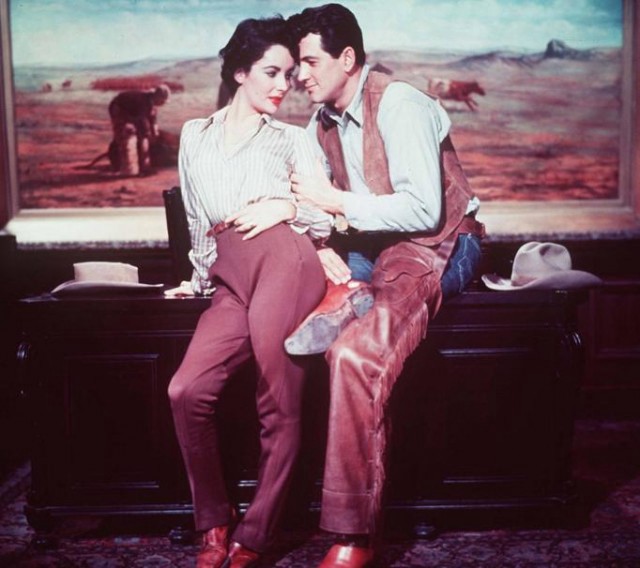
Hudson’s authenticated heterosexuality helped win him the lead in Giant, released in 1956. Giant is, not surprisingly, a sprawling, three-and-a-half-hour, Texas-sized film. It has Liz Taylor AND James Dean, and it tells a very American story of the way that money earned from the land makes life complicated and turns families against each other. But it also portrays Hudson — playing the oil baron pater familias — as a profoundly decent, hard-working, and prosperous man who’s assailed by a sexually frustrated wife and a whiny James Dean.
Dean and Hudson both earned Oscar nominations, and the film was a financial and critical success. But it also led to disaster, as Hudson, bolstered by its success, turned down roles in Sayonora, Bridge on the River Kwai, and Ben-Hur in order to appear in what should have been a prestige picture: David O. Selznick’s adaptation of A Farewell to Arms.
Selznick had done Hemingway before with a (rather mediocre) version of For Whom the Bell Tolls. He’d done prestige pictures. He’d done sprawling epics. But Farewell came at the end of his career, when he was desperate for a hit.
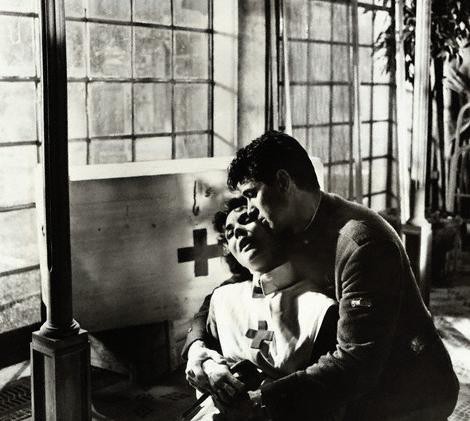
And you guys, have you read A Farewell to Arms? It’s the saddest story of all Hemingway, and that’s saying A LOT. And for as much melodrama as Rock Hudson had done, the film still flopped. Hudson lost his momentum and suffered through a string of misfires.
Until, that is, 1959, when he partnered with Doris Day in what would become his second defining role, co-starring in Pillow Talk and the two quasi-sequels that followed. In these films, Hudson and Doris Day play the most flirtatious asexuals in the world: They talk about around the fact of sex, meaning that they flirt but are never sexual. They dance, they kiss, it’s cute, but they’re never actually even close to hot.
But for many women, the perfect relationship isn’t about sex. It’s about cuteness, a little cha-cha in a nicely tailored suit, and non-consummation. In other words, the perfect relationship is the relationship with your best gay friend. And, of course, that’s what these films were about were: skillful flirtations between a saccharinely sweet, virginal female star and her closeted gay co-star.
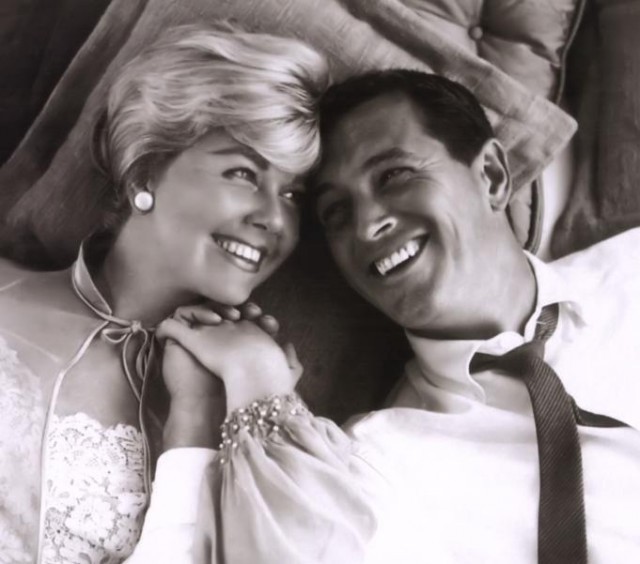
But again, this image of love sold — especially to women disillusioned with their suburban lives, slowly realizing that a dishwasher couldn’t make them happy — and made Hudson and Day the most bankable duo of the ‘60s.
Hudson went on to dabble in Westerns, sci-fi, and really bad sideburns. But he was most remembered for his roles in the Sirk melodramas and the Doris Day comedies, through which his endearing, wholly desexualized smile worked its way into a generation of women’s hearts.
Hudson’s health began to deteriorate in the early ’80s, but he still signed on to appear in Dynasty in late 1984, and it became clear how far Hudson’s health had declined. He looked far older than his 58 years, slurred his speech, and moved with difficulty.
Later that year, Hudson agreed to appear for the national premiere of Doris Day’s new television show, and looked so emaciated that the clip was rebroadcast across the nation on the nightly news.
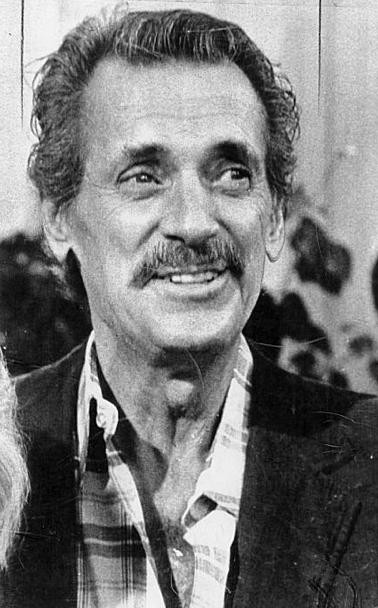
It was at this point, in late July 1985, that Hudson publicly announced he had been diagnosed with AIDS. There was a huge outpouring of support, but for the most part, I think it really just f-ed with people’s conception of of AIDS and of homosexuality.
Hudson’s announcement gave AIDS a public (and sympathetic) face, and was one of several moments in the 1980s that helped de-stigmatize the disease and those who suffered from it. It also gave a public face to homosexuality, one that was not stereotypical or the butt of a joke. These were enormous revelations, and their effects are still felt today.
But the real lesson, if there is one, is that popular images, whether of Rock Hudson or Tom Cruise, are just that — images. Sometimes they’re more rooted in fact than others, but they’re all creations, displacements. Stars aren’t men and women, they’re the images of men and women.
So Hudson’s image was fake. But is the fact that many women based their concept of an ideal man on that falsehood tragic, or just part of Hollywood celebrity culture? I mean, seriously guys — the tragedy isn’t that fans were duped. It’s that a man as seemingly lovable as Hudson had to live a lie in order to win America’s heart.
Previously: Elizabeth Taylor, Black Widow.
Anne Helen Petersen is a Doctor of Celebrity Gossip. No, really. You can find evidence (and other writings) here.